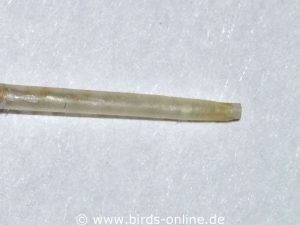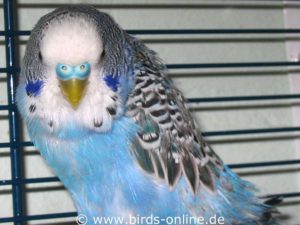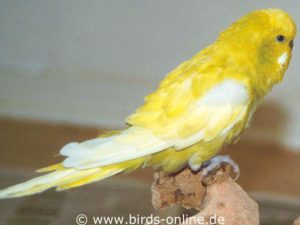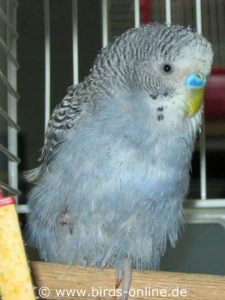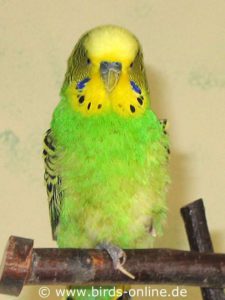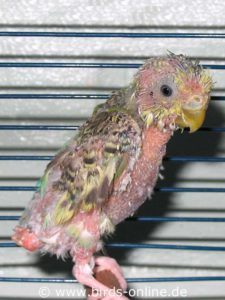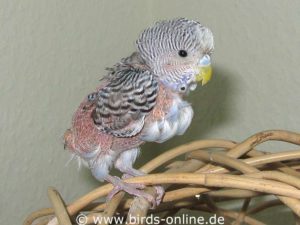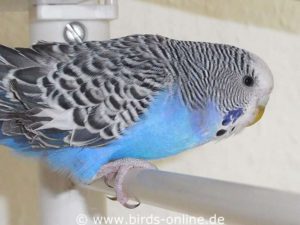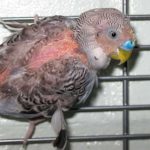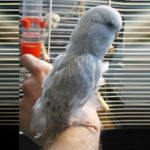- >>
- Birds Online – English
- >>
- Health and diseases
- >>
- Plumage disorders and moult
- >>
- Viral plumage disease (PBFD)
Viral plumage disease (PBFD)
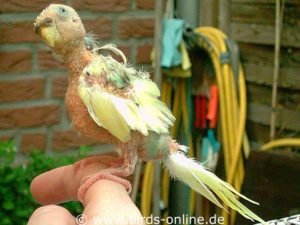
In the course of a regular moult, we normally won’t observe large-scale feather loss in budgies and other pet birds. If the plumage shows gaps or if there are bald spots on a bird’s body, this could indicate unusually strong moulting. After a few days, the first signs of new feathers should appear. However, is the plumage still patchy after weeks or do the bald spots remain for such a long time, it is, unfortunately, to be assumed that you have to deal with health issues affecting the feathers. Various causes for such issues come into consideration, for example, feather plucking. In some bird species, including budgies, a viral infection called PBFD is also quite common. It is responsible for serious plumage disorders and some other unpleasant health problems.
The abbreviation PBFD derives from “Psittacine Beak and Feather Disease”. However, because not all birds show the same symptoms, the disease is alternatively referred to as PCD (Psittacine Circoviral Disease) or PCV (Psittacine Circovirus). The latter two names indicate that the disease is caused by circoviruses. PBFD mainly occurs in large parrots and cockatoos (including cockatiels) as well as in budgies and some other small parakeet species. Furthermore, it can occur in several other bird species. Cases are reported from all over the world, both in wild populations, for example in Australian cockatoos, and birds living in captivity.
Symptoms
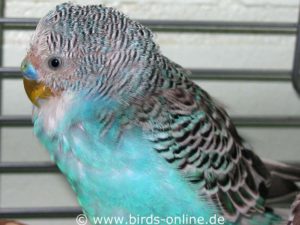
The symptoms of the disease are not the same at every stage and in all affected individuals. How PBFD manifests itself can depend, among other things, on how old a bird is when he or she becomes infected. Particularly in the early stages of the disease, there is no typical clinical picture that can immediately identify PBFD. Nevertheless, some symptoms can indicate PBFD.
First, let’s look at how the disease can manifest itself in adult birds. Right after they got in touch with the virus and have been infected, in the majority of the cases you can see nothing. You have to deal with asymptomatic carriers of the virus. Only after some time depending on the individual case, the Circoviruses cause characteristic growth disorders of the feathers. In a gradual process, the condition of the plumage deteriorates, usually from moult to moult. In many affected adult birds, you will find that the feathers grow back twisted or “crooked” at first. Later, the birds lose some feathers while moulting and will not grow back. Often, after some time, the long feathers on the wings (flight feathers) as well as the tail feathers are missing or bald spots appear on the head or body. Sometimes there is no feather loss, but the feathers change their colour what has been observed in a few bird species. So far, I (the author of Birds-online.de) have not been able to determine this in budgies.
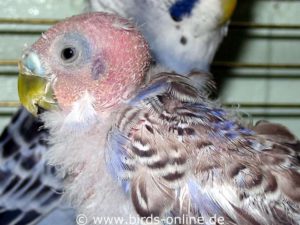
In many affected birds, the structure of the beak changes while the disease progresses. So after a while, the animals show abnormal beak growth or beak damages. In general, this symptom is easy to see by having a close look at the upper mandible (beak). The lower one may also be affected, but can hardly be seen in parrots still wearing all their feathers. This is what you have to look for: In many budgies, the beak becomes greyish or dark, porous and brittle. Some birds suffer from cracks and notches in the upper beak, which usually emanate from the sides. In other birds, the beak splinters easily.
Also, you may witness increased growth, in which the beak no longer has its original shape, but looks very chunky. More rarely, the claws are affected by the disease as well. Their texture changes in the same manner and they may grow too strong or crooked.
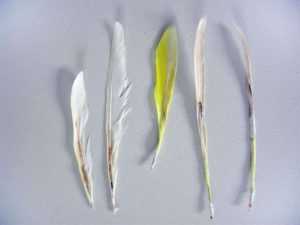
If feathers of a bird suffering from PBFD drop out, for example during moult, certain changes can be seen on them in many instances. Dark discolourations are often found in the hollow central pin, i.e. inside the quill and shaft. These are haemorrhages that have occurred during the growth of the feather. They are due to inflammation of the follicles from which the feathers develop.
In addition, many feathers show characteristic constrictions at the tip of the quill. This area, which was stuck in the skin before the feather dropped out, should be smooth and gently rounded. Those constrictions also usually occur as a result of inflammation of the feather follicles. Sometimes you can see traces of blood near these constrictions.
The previously mentioned symptoms are the visible effects of the disease. Invisible to the human eye remains the weakening of the immune system, which poses a danger to diseased birds. As a result, PBFD patients suffer infections much more frequently than healthy conspecifics with a powerful immune system. Birds who have already lost many feathers due to PBFD often suffer from additional skin diseases. On the one hand, this happens because there are no more feathers to protect the skin. Therefore eczema or other skin diseases occur frequently. On the other hand, PBFD attacks the feather follicles. Inflammations can develop in their vicinity. Also, many birds show feather cysts.
The course of the disease
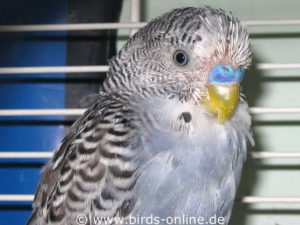
A rough distinction can be made between an acute and a chronic course; the symptoms described above are typical of the latter. However, the transition between these two forms is fluid and there are therefore many different forms of progression. It can be said, though, that adult birds in which the first symptoms appear usually show a chronic course, i.e. a gradual deterioration in their state of health. Here, the condition of the feathers steadily becomes worse with each moult until the plumage is very thinned out after a few moulting cycles. Because the head often becomes bald, feather plucking can easily be ruled out as a cause – the birds cannot pluck out their feathers on the head.
In addition, in many cases, the beak grows stronger than average and becomes crooked or malformed, which is a relatively easily recognizable feature of the PBFD. Nevertheless, this symptom can also appear due to other causes such as liver damage. A clarification by an avian vet is therefore important.
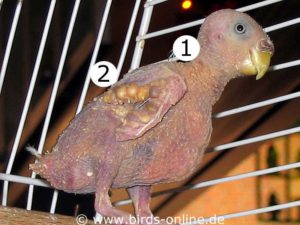
If the disease is far advanced, many birds are largely to completely naked. On the unfeathered skin, white, scabby deposits form in many infected birds after some time or reddish spots appear, see mark 1. These are inflammations, as the bare skin is extremely sensitive and bacteria such as Staphylococci can penetrate it through the smallest injuries. In addition, feather cysts occur in many affected birds. These cysts are yellowish pustules or thickenings under the skin, see mark 2.
Excessively long claws can also occur at this late stage of the disease. After the outbreak, PBFD often leads to death in adult budgies after one to a maximum of two years. However, there are reported cases in which birds have lived with the disease for up to five years or more. The survival time depends largely on how efficiently the immune system of the diseased bird still works. Therefore, it always makes sense to treat a bird suffering from PBFD with preparations and/or drugs that support the body’s defence system. Please talk to your avian vet to find out more about this topic and to choose the right medication in the individual case.
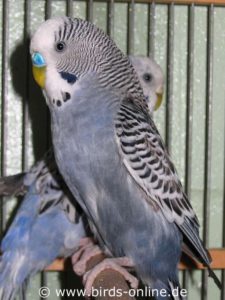
The acute course of PBFD, which is usually seen in young birds who are just a few days or weeks old, is different. In general, they die very quickly, since the disease causes immunodeficiency, diarrhoea, vomiting and fatigue. If young birds who are still growing become infected with Circoviruses, in most cases the incubation period of the disease is just a few days to about two weeks. Death usually occurs soon after the onset of the disease, because young animals react extremely sensitively to the Circoviruses during growth.
In addition to the forms mentioned, there is a third variant that does not represent a real progression form in the true sense of the word. A bird may be an asymptomatic carrier of the virus without falling ill himself (or herself). Thus, this outwardly inconspicuous and healthy animal can transmit the disease to conspecifics without ever getting sick and showing symptoms. This makes PBFD a particularly treacherous disease because it cannot be seen with the naked eye if a bird doesn’t show any symptoms. Only a laboratory test can clarify whether a bird is affected or not, see below.
Therein lies a major problem: Many bird owners do not have new animals tested for viruses. Because the birds do not look sick, the owners assume that they are healthy – with fatal consequences for other birds. Without an initial examination, which includes testing for circoviruses, it is easy for a whole flock of previously healthy birds to become infected. Anyone who adopts a new bird to socialize with other ones should therefore always have a PBFD test carried out as a precaution!
Transmission
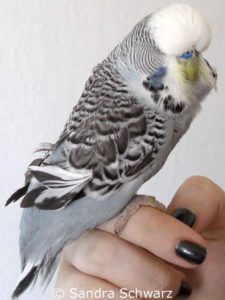
Infected birds excrete the viruses through their faeces. The dust from their feathers as well as the seeds from their crop are infectious. In most cases, newly hatched birds get in touch with the viruses in the nest if their parents are ill. This may even happen if the parents show no symptoms. Adult birds can also become infected by inhaling virus-containing dust or by contact with virus-containing faeces or food from another bird’s crop.
In the case of infection, the incubation period, i.e. the time until the disease breaks out, depends on the age of the bird, among other things. Newly hatched birds usually fall ill after a few days. In adult birds, on the other hand, it can take several months for them to show the first symptoms of PBFD. According to the literature, a few cases have also been observed in which the time between infection and onset of the disease has been several years. The average incubation period in adult birds is reported to be two months.
Diagnosis
To find out whether a bird is infected with circoviruses, a special laboratory test can be carried out. A small amount of fresh blood is needed for this. To obtain this, a few feathers are torn out according to certain specifications. It is best to leave this to an experienced veterinarian. Every new bird as well as every suspected case should be examined accordingly. Depending on the laboratory and the order situation, it usually takes about three to seven days until the results are available.
But there is a “but”: The test results are not 100% reliable in all cases. A bird that has tested negative may still be infected with PBFD. Sometimes infected birds temporarily do not excrete viruses, so that a test that is carried out exactly in such a period leads to a negative result, although the bird carries circoviruses – you have to deal with a false-negative test result. Furthermore, it is conceivable that the torn feathers did not carry enough genetic material and the result was therefore false-negative.
So in case of doubt, you should have a second test carried out after three months. Theoretically, this test could also produce a false-negative result. But the probability of two tests producing false-negative results is not so extremely high.
To rule out a false-negative result due to a lack of genetic material, a test can be commissioned to determine the sex of the bird at the same time. If sex determination is not possible based on the blood and feather sample, then the PBFD test cannot provide a reliable result either. Although this particular test is more expensive than simply testing for Circoviruses, you can easily recognize false-negative test results in this way.
Treatment and further measures
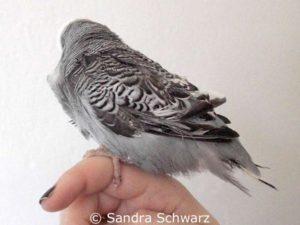
Unfortunately, treatment to cure the disease does not currently exist for PBFD. Birds who are ill with PBFD or who are asymptomatic carriers of Circoviruses should be nourished as healthy and balanced as possible. Care must be taken to support and strengthen their immune system. Your avian veterinarian will certainly be able to recommend suitable preparations and tell you which food is best for your feathered patients.
Once a bird has been diagnosed with PBFD, it is advisable to have all birds from the same flock examined as well. This is the only way to ensure that you have a clear understanding of the situation. It is often recommended to remove infected birds who have lived together with other birds for a long time from the flock when the disease becomes known. Unfortunately, however, the transmission of the disease has probably already taken place, which is why this measure is unnecessary. Make sure that you never bring infected birds into contact with healthy animals. This may mean, for example, that you can no longer simply take your birds into care elsewhere during your holiday since any bird affected by PBFD is contagious.
Throughout their lives, if necessary, the claws and beaks of the diseased birds must be shortened and the occurrence of secondary infections must be prevented as far as possible. Also regarding these details, owners of PBFD birds should contact an expert veterinarian.
For some time now, a vaccine against the PBFD-causing circoviruses has been tested in several countries. Unfortunately, this vaccine is not yet available everywhere.
No solitary keeping of PBFD-positive birds!
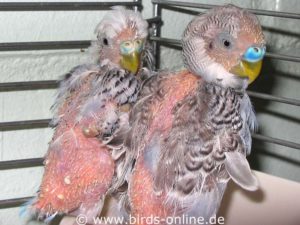
Birds being affected by PBFD should never be kept alone. Unfortunately, PBFD is now very widespread (at least in Germany), so many birds are bearing the same fate. As sad as it may be to keep several sick birds at the same time, the animals should be able to live in the company of conspecifics. It is, therefore, best to take in other infected birds or give your sick bird to a household where PBFD-positive birds also live.
Ethical aspects
When it comes to PBFD, some ethical aspects should be considered. Some experts take the view that infected birds should be killed immediately after detection of the disease so that they cannot infect other birds. According to these experts, the killing should also take place if the animals are still doing well, i.e. even if they do not (yet) show any symptoms.
Some other people consider this approach to be unethical because they believe that PBFD birds can be socialized with each other and, at best, can continue to live for a few years with a good quality of life. During this time, however, there is always the risk that they will excrete viruses and that they will come into contact with healthy birds, for example in the form of dust from the feathers, which adheres to the clothing of the owners. It can therefore happen under certain circumstances that an owner of birds suffering from PBFD visits another owner with healthy birds and transmits the virus via this dust trapped in the clothing. All owners of PBFD-positive birds should be aware of this risk and act responsibly.
From the point of view of those who consider the immediate killing of infected birds to be useful, it is ethically unacceptable to expose healthy birds to potential danger, as can be caused by the dust adhering to the clothing. No matter how you twist and turn the whole thing, both views are at least partially comprehensible and every bird owner who is confronted with the diagnosis of PBFD should be aware of this ethical dilemma. It is up to you to make a decision that is agreeable to you and morally acceptable.
Similar diseases
Although the plumage disorders and beak issues associated with a progressive PBFD infection can often be seen at a glance, it is usually not possible to identify an affected bird as suffering from PBFD. The reason for this is that other (viral) diseases can cause identical symptoms. One example is the French moult caused by Polyomavirus. In addition, birds who are plucking their feathers can also be confused with an animal suffering from PBFD. The following pictures give you an idea of the complexity of this topic.
Severe nutrient deficiencies can lead to massive plumage disorders, especially in young birds, which are similar to those triggered by PBFD disease. If a young bird is insufficiently supplied with nutrients while the animal is still growing, its organism does not have enough resources to build healthy feathers. However, the problem can affect the growing bird even earlier: If its mother is insufficiently supplied with nutrients during the production of the eggs, the yolk from which the embryo feeds in the egg does not become sufficiently nutritious. This results in dying embryos or in birds who are very weak when they are just hatched. Many of these birds show feather growth disorders.
Conclusion
Any bird with severe plumage disorders should be examined by an avian vet who will decide whether a test should be run or not. This is the only way to gain certainty about the state of health of the respective bird. No bird owner should get involved in eye diagnoses, because they are too insecure!

